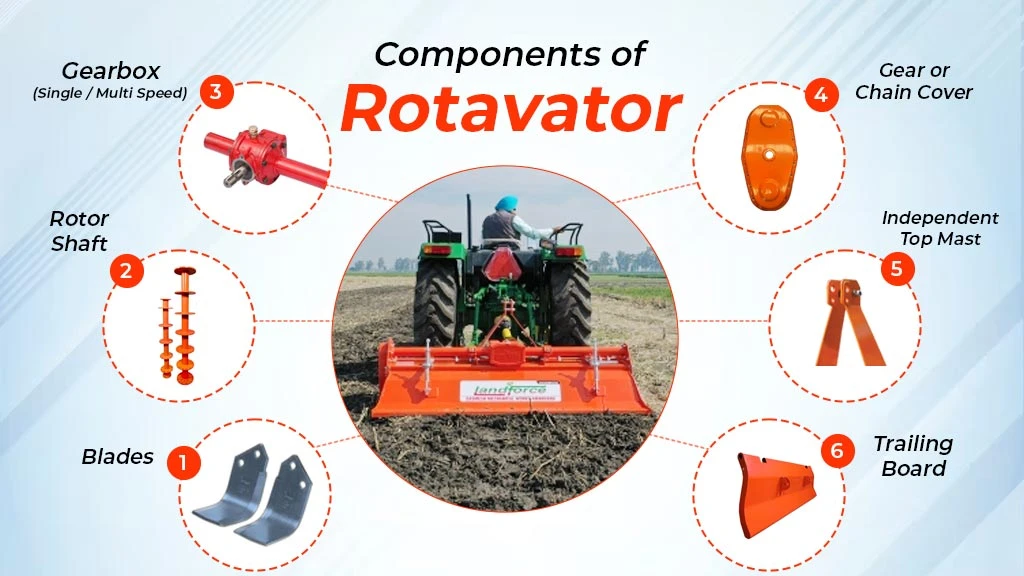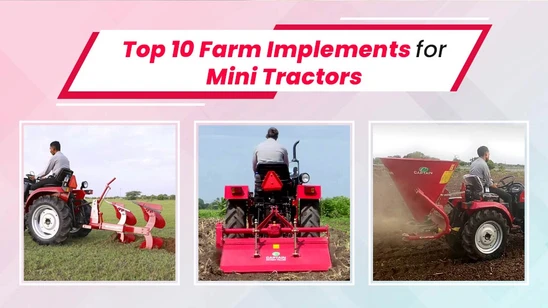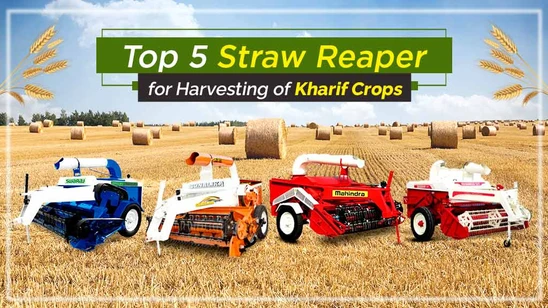How to Use and Maintain Your Rotavator?

Table of Contents
- Introduction
- Types of a Rotavator
- Components of a Rotavator
- How to Use Your Rotavator for Farming?
- How to Maintain a Rotavator?
- Conclusion
Introduction
Preparing soil for plantation has always been challenging work to perform. While manual digging, ploughing, and tilling were common in the past, things have changed now, and now all these tasks can be completed using a rotavator with less effort. It is a tractor-operated implement that has proven to be a success and reduces manual effort to a great extent.
A rotavator is also known as a rotary tiller. It is a versatile secondary tillage equipment designed to prepare the soil by mechanically pulverising, cutting, mixing, and levelling the soil simultaneously. It makes the process of preparing soil simpler.
Using a rotavator can significantly reduce the manual effort required for soil preparation, but following the manufacturer's instructions and exercising caution while operating the machine is essential. If you are new to using a rotavator, consider seeking guidance from experienced farmers or equipment rental professionals.
Types of Rotavator
One can easily go for any rotavator based on their farming needs but before that we need to understand the different types of rotavators.
Heavy Duty Rotavators
Farmers who work on large area farming fields for cultivation usually require heavy-duty rotavators. These are built large with robust construction, require more horsepower, and have larger blades. Some of the popular rotavators are:
Shaktiman Semi Champion Plus SCP 370: It is a 12 feet rotavator requiring 80-100 HP of tractor power.
Landforce Robusto RTH12MG84: It is a 12 feet rotavator that requires tractor power of 90 HP.
Medium Duty Rotavators
Medium duty rotavators are focused on delivering a balance between efficiency and power. These are more commonly used in regular farming activities like gardening or preparing soil for crops. These are less heavily built than the heavy-duty rotavators and fall into a more affordable segment. Some of the popular rotavators are:
Fieldking Gold FKRTGMG5-175: It is a 6 feet rotavator that requires tractor power of 45-50 HP.
Swaraj Gyrovator SLX-175: It is a 6 feet rotavator that requires tractor power of 50-55 HP.
Light Duty Rotavators
Light duty rotavators are light, less powerful, and compact compared to other types of rotavator models. These are commonly used in small-scale farming activities such as landscaping or gardening.
These are primarily used by gardeners or homeowners who have small land sizes. The positive attribute of these rotavators is that they are easy to manoeuvre and are less expensive than the other two rotavator types. Some of the popular rotavators are:
Jadhao Layland CM 1050: It is a 3 feet rotavator requiring 22-30 HP tractor power.
Agrotis Mini 0.8: It is a 3 feet rotavator that requires tractor power of 12-22 HP.
Components of a Rotavator

Rotavator is a flexible equipment that offers multiple uses and thus can serve various applications. Hence, it is necessary to understand the exact purpose, functioning and use of rotavator. There are multiple components of a rotary tiller, such as:
- Blades
- Gearbox (single or multi speed)
- Rotor shaft
- Independent top mast
- Trailing board
- Gear or chain cover
Having understood what a rotavator is and its importance, let us see a step-by-step guide to use and maintain it.
How to Use Your Rotavator for Farming?
Using your rotavator effectively is key to preparing the soil in best possible way for sowing and planting crops. So, let us see how to use your rotavator.
Tractor Compatibility: Ensure that your tractor is compatible with a rotavator attachment. The tractor should have the necessary PTO power to operate the rotavator.
Attachment Setup: Attach the rotavator to the tractor according to the manufacturer's instructions. This usually involves connecting the rotavator's driveline to the tractor's power take-off (PTO) shaft and securing it properly.
Depth Adjustment: Set the desired tilling depth on the rotavator. This is typically done by adjusting the depth control mechanism on the rotavator itself. The depth depends on the purpose of tilling – deeper for initial soil breaking, shallower for seedbed preparation.
Set Up the Tractor & Begin Tilling: Start the tractor's engine and engage the PTO to power the rotavator. Then drive the tractor slowly into the tilling area. The tractor's forward motion will turn the rotavator's tynes, breaking up and cultivating the soil.
Overlapping Passes: As you progress, overlap each pass slightly to ensure complete coverage of the area. This prevents leaving un-tilled strips of soil.
Control Speed: Maintain a steady pace to allow the rotavator to work through the soil effectively. Avoid excessive speed, as this might not yield optimal results.
Turning and Cornering: When turning the tractor, lift the rotavator out of the soil to prevent damage and maintain control. Lower it again once you're on the right path.
Managing Depth and Resistance: If you encounter compacted or resistant soil, consider making multiple passes at gradually increasing depths. This will help break up the soil effectively.
Maintenance: Clean the rotavator of any accumulated soil and debris after use. Properly store the equipment to prevent rust and damage.
How to Maintain a Rotavator?
Regular maintenance can prevent breakdowns and keep the equipment functioning optimally. Here are some maintenance tips for your rotavator:
Pre-Use Inspection: Inspect the rotavator for any visible damage, loose bolts, or worn parts. Check the driveline, blade, and gearbox for any signs of wear or damage.
Lubrication: Grease all fittings and moving parts. This includes bearings, pivot points, and gearbox components. Regularly lubricate the PTO shaft and universal joints to prevent friction and wear.
PTO Shaft Maintenance: Check the PTO shaft for any signs of damage, including bends, cracks, or missing shields. Ensure that the PTO shaft is securely connected and locked in place.
Cleaning: After each use, clean the rotavator thoroughly to remove soil, debris, and plant material. Pay special attention to the tines and other moving parts. A clean rotavator is less likely to suffer from corrosion and mechanical issues.
Regular Servicing: Schedule regular maintenance sessions, including oil changes, gearbox inspections, and overall system checks. Follow the manufacturer's recommended service intervals.
Conclusion
Owning a rotavator can enhance gardening efforts and save time and effort while promoting healthier plant growth. One can follow this blog on types of rotavators, their uses, assembly, and maintenance to ensure rotavators’ longevity and optimal performance.


सम्बंधित ब्लॉग्स















